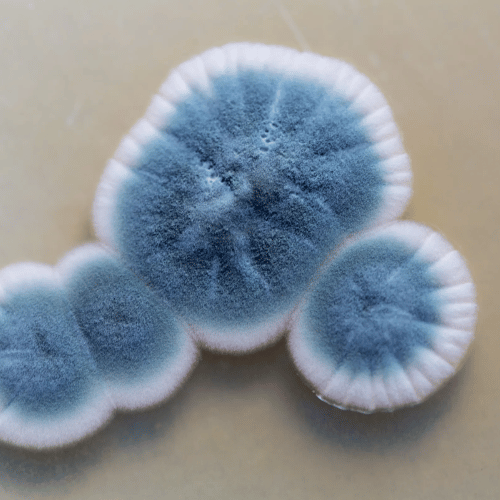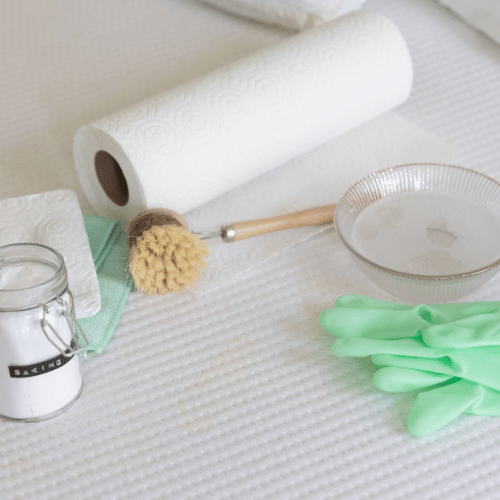Do you have a moldy mattress? It’s not a pleasant sight and can be difficult to get rid of. Fortunately, it’s possible to remove the mold and make your mattress look as good as new.
The first step is to identify the source of the problem. Mold thrives in damp environments, so if your mattress is in an area that tends to collect moisture, that may be causing the issue. Once you’ve identified the source of the problem, you can move on to cleaning and treating your mattress.
Finally, with some basic cleaning supplies and a few simple steps, you can remove the mold from your mattress for good!
So let’s get started – read on for our guide for more expansive steps on how to get mold out of your mattress!
Definition Of Mold

Mold is a type of fungus that grows in wet and damp environments. It’s often black, green or white in color. Mold can cause health problems and damage to the property it grows on. It’s important to be aware of the indicators of mold presence, as well as how to get rid of it once you have it.
Mold can thrive in mattresses if they stay wet for an extended period. This could be due to spills, pet accidents, or even humidity levels in the room. Once mold has taken hold, it can spread quickly and become difficult to remove without professional help.
It’s important to act fast if you suspect your mattress may have mold growth. Inspect the mattress regularly and take steps to prevent future mold growth by keeping the environment dry and clean.
Indicators Of Mold Presence
The presence of mold can often be identified by its musty smell, which may be the first indicator that something is amiss.
This odor will become stronger as the mold spreads, and can be an indication that it’s time to take action.
Visible signs are also helpful in detecting the presence of mold, such as discoloration on the mattress fabric or even small spots of visible fungi.
Another way to determine if there is mold present is to check for dampness or wetness on the surface of the mattress.
Mold thrives in moist environments and so any areas where moisture has been trapped can become a breeding ground for growth. You should also take note of any areas where condensation may have occurred due to temperature changes in the room or from sleeping habits.
It’s important to act fast when you detect these signals of mold presence, as it can spread quickly if not taken care of appropriately.
Identifying The Source

It is important to identify the source of moisture that has caused the mold growth in order to stop it from spreading further. This could be from a leaky window, pipe, or even a humidifier.
It’s also possible for water vapor from showers and cooking to collect on surfaces, so it’s important to take note of these areas as well.
Additionally, excess perspiration due to sleeping habits may be an issue and must be addressed.
Once you have identified the source of moisture, it’s time to start dealing with the mold itself.
This process includes removing any visible signs of mold, cleaning away any spores or residue left behind, and finally applying treatments that will prevent future growth.
It’s important to remember that this is a delicate process and care should always be taken when handling the mattress.
Taking action quickly when detecting mold is crucial in preventing further damage or health risks associated with exposure.
Types Of Cleaning Solutions
Now that the source of moisture has been identified, it’s time to start cleaning up the mold. A variety of solutions can be used to effectively remove any visible signs of mold and prevent future growth.
From natural remedies to store-bought products, there are a plethora of options available when it comes to cleaning up mold.
For those looking for a more natural approach, white vinegar is a great option.
Vinegar is well known for being an effective cleaner and deodorizer, so it can be used safely on mattresses without worry about damaging them. It’s important to dilute the vinegar with water in order to avoid any discoloration or damage to fabrics.
Alternatively, baking soda can also be used as a cleaning solution; simply mix with water and apply directly onto affected areas.
For those looking for products specifically designed for removing mold from mattresses there are several available on the market today.
These products come in both spray and liquid form and contain powerful ingredients such as bleach or hydrogen peroxide that will help eliminate any spores or residue left behind by the mold.
Be sure to always follow directions when using these products as they may cause discoloration or other damage if not used properly.
With all these solutions available, getting rid of mold from your mattress doesn’t have to be a daunting task!
Preparing The Mattress For Cleaning

Before any cleaning can begin, the mattress needs to be prepped. This involves removing all bedding and vacuuming the affected area to remove any loose spores or particles.
It’s important to make sure that all areas are vacuumed thoroughly, paying special attention to seams and folds where mold may hide.
Once the mattress is free of debris, it’s time to start tackling the mold itself.
When it comes to preparing a mattress for cleaning, safety is always a priority. Before starting, it’s important to put on protective gear such as gloves and a face mask in order to avoid any contact with the mold or its spores.
Additionally, it’s best practice to open windows and doors for ventilation in order to help dissipate any fumes from the cleaning solutions being used.
Steps For Removing Mold
The thought of mold growing on your mattress is enough to send shivers down your spine. It’s a sickening, slimy sight that no one should ever have to witness.
However, with the right steps and procedures, it can be taken care of in no time! Here’s how:
- Mix a solution: Combine one cup of bleach with one gallon of water for an effective mold-killing mixture.
- Apply the solution: Using a spray bottle or cloth, apply the solution directly onto the affected areas and scrub gently until all visible evidence of mold has been removed. Make sure to get into any nooks and crannies where mold may have taken hold.
- Rinse and repeat: Once all visible signs are gone, rinse the mattress with clean water and use a dry towel to blot out any remaining moisture. Repeat as necessary until all signs of mold are gone.
These three simple steps will help you rid your mattress of unsightly mold in no time!
Drying And Disinfecting The Mattress
Once the mold has been removed, it’s time to dry and disinfect the mattress. To do this, start by opening any windows or doors in the room to allow for proper ventilation.
Then, use a fan to blow air across the mattress, helping it dry out faster.
Finally, use a vacuum cleaner with a HEPA filter to remove any remaining spores and particles.
Disinfecting your mattress is just as important as removing the mold itself. To do this, mix one cup of vinegar with one gallon of water and apply it with a spray bottle or cloth.
Don’t forget to scrub around all creases and seams in order to get into every nook and cranny! Allow your mattress to air-dry before using again.
These steps will help ensure that your mattress is clean and free of mold spores.
How To Prevent Future Infestation
Time stands still as I gaze upon the mattress, now clean and free of mold. The memories of its former state linger in my mind; it had been a daunting task to remove the mold, but with dedication and fortitude, I have conquered it.
The next step is to focus on preventing future infestations. Proper cleaning and ventilation are essential for keeping mattresses safe from mold.
Vacuum regularly with a HEPA filter vacuum cleaner to remove dust and debris that can lead to mold growth. If you live in a humid area, use a dehumidifier or air conditioner to keep indoor humidity levels low.
Finally, consider using a breathable mattress protector or encasement when storing mattresses for long periods of time.
This can help protect your mattress from spills and other moisture sources that may lead to mold growth. With these preventative measures in place, you can rest assured that your mattress will remain free of mold for years to come.
Professional Treatment Options
Having taken the necessary steps to prevent future infestations, there may be cases where professional treatment is needed. If your mattress has already been contaminated with mold, it may be time to call in the experts. There are a variety of services available that can help remove and eliminate the mold from your mattress, such as steam cleaning and dry-ice blasting.
These treatments may also include the use of anti-fungal solutions to reduce any remaining spores or colonies. It’s important to remember that these solutions should only be applied by trained professionals, as using them incorrectly can cause further damage to your mattress. In addition, it’s a good idea to make sure that the company you hire is experienced in dealing with mold and follows proper safety protocols for its employees.
The final step in professional treatment is to monitor the area for future signs of contamination. A qualified technician will inspect your mattress and surrounding environment after treatment to ensure that no new mold has formed or grown back. With vigilance and regular maintenance, you can enjoy a safe sleeping environment free of toxic mold growth.
Health Risks Associated With Mold Exposure
The presence of mold in your home can be a cause for concern, as it can lead to serious health risks. Exposure to mold spores can cause a range of symptoms, such as respiratory issues, skin irritation and allergic reactions.
In some cases, it can even result in long-term illnesses or chronic conditions.
If you have been exposed to mold on your mattress, it’s important to take action immediately and seek medical advice.
Your doctor may recommend certain medications or treatments depending on the severity of your symptoms. Additionally, they may advise you on ways to reduce your exposure to mold in the future.
It’s important to remember that the health risks associated with mold exposure should not be taken lightly.
Taking steps to ensure that your mattress is free from contamination is key in avoiding potential problems down the line.
Regular maintenance and cleanings can go a long way towards keeping your bedding safe and healthy.
Frequently Asked Questions
How Long Does It Take For Mold To Start Growing On A Mattress?
Mold growth on mattresses can be a problem. It’s important to know how long it takes for mold to start to grow, so you can take steps to prevent it.
It all depends on the environment and conditions around the mattress. If it is exposed to moisture and darkness, then mold can begin to form in as little as 24-48 hours.
The exact time frame varies depending on the humidity and temperature, as well as other factors such as ventilation.
The best way to prevent mold from growing on your mattress is by keeping it dry and in a well-ventilated area.
Make sure there is plenty of sunshine coming through the windows during the day, and if possible, use a dehumidifier or air conditioner in order to keep humidity levels low.
You should also regularly inspect your mattress for signs of mold growth, such as discoloration or an unpleasant musty smell.
Taking these precautionary steps can help you keep your mattress clean and free from mold for years to come.
Is There A Way To Test For Mold Without Calling In A Professional?
Testing for mold can be a tricky business. It requires an expert eye to identify the type of mold, the extent of infestation, and how best to treat it.
But there are several methods that you can use to test for mold on your own before deciding if it is necessary to call in a professional.
The first step is to look for visible signs of mold growth such as discoloration or musty odors.
If you observe any of these signs, you will need to take further steps to confirm the presence of mold in your home:
1. Evaluate air quality: You can purchase air quality testing kits from hardware stores or online retailers that will help you measure levels of airborne particles like mold spores.
2. Inspect surfaces and fabrics: Check areas like carpets, furniture, bedding, and walls for any discoloration or dampness that could indicate mold growth.
3. Do a moisture test: You can buy a moisture meter from most home improvement stores to measure the amount of water in walls, floors, and ceilings. High levels could be indicative of a potential mold problem.
It’s important to remember that simply looking for signs of visible mold isn’t enough – it’s also important to test your home environment for invisible elements such as moisture levels that could foster future growths.
By taking these proactive steps, you can save yourself time and money in the long run by catching any potential problems before they become unmanageable.



